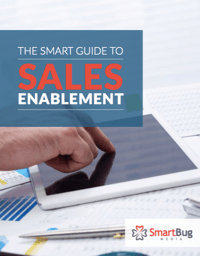
How to Transition Your Sales Team from Outbound to Inbound
January 18, 2019
By Sandy Moore
Interested in implementing an inbound sales methodology? There are several steps you can take to make the process smoother while transitioning your team from an outbound to inbound sales approach.
Let’s start by defining outbound sales. Outbound sales is an older, more traditional approach to sales. It is where a sales rep reaches out to a prospect, whether by networking or by cold-calling a list, to sell a particular product or service. The actions of the sales rep may be outlined in a sales process document and tracked in a sales tool such as a CRM (customer relationship management).
An inbound sales approach may also be outlined in a sales process document and tracked in a CRM, but it allows the sales rep to focus on warmer, more educated leads and to change the narrative of the sales conversations to be more helpful and personalized for the prospect. The ultimate goal is to close sales that benefit both the prospect and the sales rep.
A transition from outbound to inbound sales is more than just a change in the sales process—it is a behavioral change. It is a change in the way that sales teams approach a prospect to close a deal. Instead of a sales rep focusing on what they can say to help close the sale (as they do in outbound sales), the inbound sales methodology encourages the sales rep to focus on how they can help the prospect solve their problem.
When implementing an inbound sales approach, it is important to educate and provide sales training to your entire sales team on the inbound sales methodology. The methodology aligns with the way buyers make purchase decisions. The four main steps within the inbound sales methodology are Identify, Connect, Explore, and Attract, and these steps overlap with the Buyer’s Journey. These steps assist sales reps with understanding which prospects they can help and where they should focus their efforts to help buyers make a purchase decision.
Today, buyers are much more knowledgeable as they research ways to solve their problems using online and offline resources. The buyer may reach each stage in the Buyer’s Journey long before they ever speak to a sales rep, and therefore, may be highly educated before their first conversation with a sales rep. Therefore, a sales rep becomes most effective when they become a trusted advisor to the prospect, offering information and resources to help the prospect solve their problems during the sales process. A sales rep should shift their mindset and act as a consultant and trusted advisor to the prospect as they execute an inbound sales approach.
There are many useful tools to help sales teams successfully execute an inbound sales strategy and become trusted advisors to prospects as they move away from an outbound sales approach. Most of these tools focus on gathering knowledge and intelligence about the prospect as they interact with the sales rep and the company’s online resources. HubSpot is one example of a tool that offers an all-in-one platform to organize, monitor, and track information about prospects engaging with your company’s digital assets. By having insight into what the prospect is researching online, the sales rep can provide additional, helpful resources during the sales process based on what is most valuable to that particular prospect.
With inbound sales, the lead nurturing process doesn’t stop once a prospect is speaking with a sales rep. A sales rep should continue to nurture the prospect by providing educational resources at all stages of the sales process. Resources may include comparison sheets, guides, e-books, white papers, blog articles, or infographics that outline ways to overcome the prospect’s pain points. Resources should be mapped to the buyer personas and each stage within the Buyer’s Journey. These resources should be stored in a shared folder to be used by the entire sales team. It can also be useful to outline email templates and sales presentations for sales reps to utilize during the sales process. The provided language should then be personalized by the sales rep to be most useful to the prospect instead of the standard promoting the company’s products and services to push a sale.
As you transition from an outbound to inbound sales approach, measure the results from implementing the new inbound sales strategy. Determine which sales resources your prospects are engaging with the most and which ones helped generate new customers. Track your sales reps’ activities, and monitor and measure their performance. Keep an eye on key metrics such as sales cycle and revenue generation, and watch for improvements within the sales process. Schedule ongoing meetings with the sales team to discuss what is working and what still needs improvement.
Remember, switching from outbound to inbound sales takes time, and it requires a behavioral and process change within the organization. There isn’t a one-size-fits-all approach for all sales teams. If your sales team focuses on providing personalized and helpful information to prospects, the results should yield more customers that are happy and truly benefit from your company’s services.

About the author
Sandy Moore Sandy Moore is a Senior Director of Account Strategy at SmartBug Media. She has more than 20 years of experience in marketing with extensive knowledge in outbound and inbound marketing, advertising sales, promotions, public relations, and sales enablement. Read more articles by Sandy Moore.









